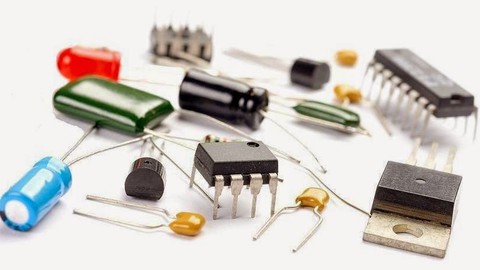
Basic Electronics
Basic Electronics, available at Free, has an average rating of 4.33, with 5 lectures, based on 144 reviews, and has 3666 subscribers.
You will learn about Students will be learn basic concepts of electronics This course is ideal for individuals who are Diploma and Graduates students of Electronics and Telecommunications Engineering. It is particularly useful for Diploma and Graduates students of Electronics and Telecommunications Engineering.
Enroll now: Basic Electronics
Summary
Title: Basic Electronics
Price: Free
Average Rating: 4.33
Number of Lectures: 5
Number of Published Lectures: 5
Number of Curriculum Items: 5
Number of Published Curriculum Objects: 5
Original Price: Free
Quality Status: approved
Status: Live
What You Will Learn
- Students will be learn basic concepts of electronics
Who Should Attend
- Diploma and Graduates students of Electronics and Telecommunications Engineering.
Target Audiences
- Diploma and Graduates students of Electronics and Telecommunications Engineering.
Basic Electronics comprises the physics, engineering, technology and applications that deal with the emission, flow and control of electrons in vacuum and matter. It uses active devices to control electron flow by amplification and rectification, which distinguishes it from classical electrical engineering which uses passive effects such as resistance, capacitance and inductance to control current flow.
Electronics has had a major effect on the development of modern society. The identification of the electron in 1897, along with the subsequent invention of the vacuum tube which could amplify and rectify small electrical signals, inaugurated the field of electronics and the electron age.
The MOSFET was the first truly compact transistor that could be miniaturized and mass-produced for a wide range of uses, revolutionizing the electronics industry, and playing a central role in the microelectronics revolution and Digital Revolution. The MOSFET has since become the basic element in most modern electronic equipment, and is the most widely used electronic device in the world.
Electronics is widely used in information processing, telecommunication, and signal processing. The ability of electronic devices to act as switches makes digital information-processing possible. Interconnection technologies such as circuit boards, electronics packaging technology, and other varied forms of communication infrastructure complete circuit functionality and transform the mixed electronic components into a regular working system, called an electronic system; examples are computers or control systems. An electronic system may be a component of another engineered system or a standalone device. As of 2019 most electronic devices use semiconductor components to perform electron control. Commonly, electronic devices contain circuitry consisting of active semiconductors supplemented with passive elements; such a circuit is described as an electronic circuit. Electronics deals with electrical circuits that involve active electrical components such as vacuum tubes, transistors, diodes, integrated circuits, optoelectronics, and sensors, associated passive electrical components, and interconnection technologies. The nonlinear behavior of active components and their ability to control electron flows makes amplification of weak signals possible.
The study of semiconductor devices and related technology is considered a branch of solid-state physics, whereas the design and construction of electronic circuits to solve practical problems come under electronics engineering. This article focuses on engineering aspects of electronics.
Course Curriculum
Chapter 1: Introduction of Basic components used in Electronics.
Lecture 1: Introduction of Basic components used in Electronics.
Chapter 2: Semiconductor Diode.
Lecture 1: Semiconductor Diode.
Chapter 3: Rectifiers and Filters.
Lecture 1: Rectifiers and Filters.
Chapter 4: Transistor.
Lecture 1: Transistor.
Chapter 5: Concept of Regulators and Power Supply.
Lecture 1: Concept of Regulators and Power Supply.
Instructors
-
Milind Jadhav
Lecturer in Department of Electronics and Telecommunications
Rating Distribution
- 1 stars: 9 votes
- 2 stars: 8 votes
- 3 stars: 37 votes
- 4 stars: 45 votes
- 5 stars: 45 votes
Frequently Asked Questions
How long do I have access to the course materials?
You can view and review the lecture materials indefinitely, like an on-demand channel.
Can I take my courses with me wherever I go?
Definitely! If you have an internet connection, courses on Udemy are available on any device at any time. If you don’t have an internet connection, some instructors also let their students download course lectures. That’s up to the instructor though, so make sure you get on their good side!
You may also like
- Best Emotional Intelligence Courses to Learn in March 2025
- Best Time Management Courses to Learn in March 2025
- Best Remote Work Strategies Courses to Learn in March 2025
- Best Freelancing Courses to Learn in March 2025
- Best E-commerce Strategies Courses to Learn in March 2025
- Best Personal Branding Courses to Learn in March 2025
- Best Stock Market Trading Courses to Learn in March 2025
- Best Real Estate Investing Courses to Learn in March 2025
- Best Financial Technology Courses to Learn in March 2025
- Best Agile Methodologies Courses to Learn in March 2025
- Best Project Management Courses to Learn in March 2025
- Best Leadership Skills Courses to Learn in March 2025
- Best Public Speaking Courses to Learn in March 2025
- Best Affiliate Marketing Courses to Learn in March 2025
- Best Email Marketing Courses to Learn in March 2025
- Best Social Media Management Courses to Learn in March 2025
- Best SEO Optimization Courses to Learn in March 2025
- Best Content Creation Courses to Learn in March 2025
- Best Game Development Courses to Learn in March 2025
- Best Software Testing Courses to Learn in March 2025






















